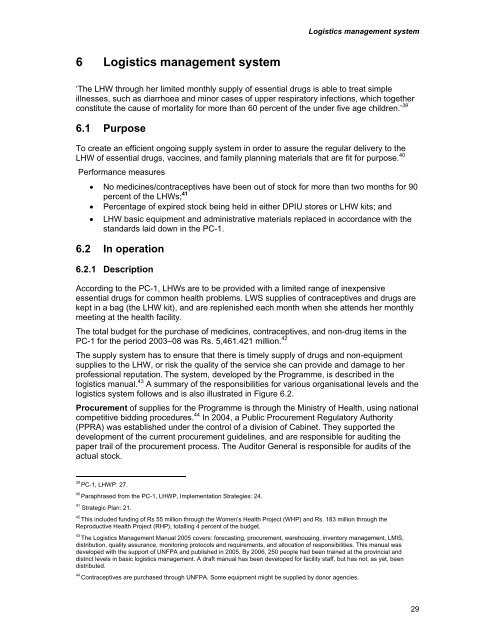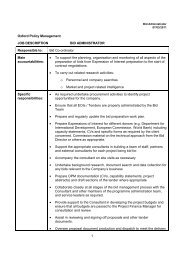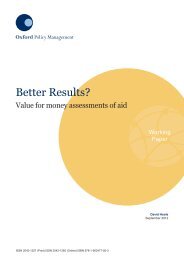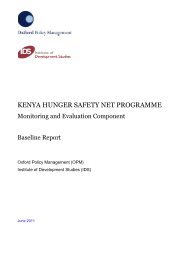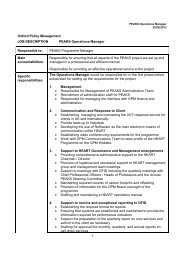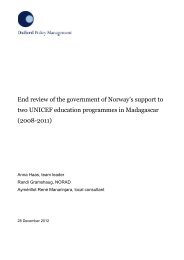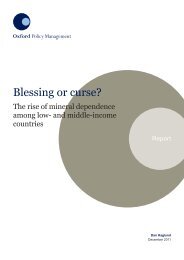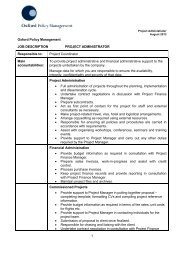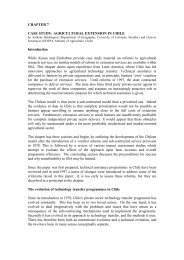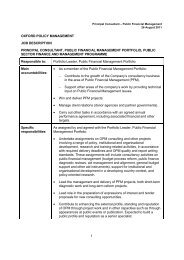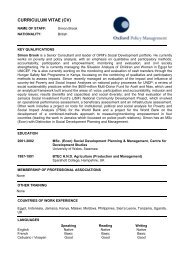LHW Systems Review - Oxford Policy Management
LHW Systems Review - Oxford Policy Management
LHW Systems Review - Oxford Policy Management
You also want an ePaper? Increase the reach of your titles
YUMPU automatically turns print PDFs into web optimized ePapers that Google loves.
Logistics management system6 Logistics management system‘The <strong>LHW</strong> through her limited monthly supply of essential drugs is able to treat simpleillnesses, such as diarrhoea and minor cases of upper respiratory infections, which togetherconstitute the cause of mortality for more than 60 percent of the under five age children.’ 396.1 PurposeTo create an efficient ongoing supply system in order to assure the regular delivery to the<strong>LHW</strong> of essential drugs, vaccines, and family planning materials that are fit for purpose. 40Performance measures• No medicines/contraceptives have been out of stock for more than two months for 90percent of the <strong>LHW</strong>s; 41• Percentage of expired stock being held in either DPIU stores or <strong>LHW</strong> kits; and• <strong>LHW</strong> basic equipment and administrative materials replaced in accordance with thestandards laid down in the PC-1.6.2 In operation6.2.1 DescriptionAccording to the PC-1, <strong>LHW</strong>s are to be provided with a limited range of inexpensiveessential drugs for common health problems. LWS supplies of contraceptives and drugs arekept in a bag (the <strong>LHW</strong> kit), and are replenished each month when she attends her monthlymeeting at the health facility.The total budget for the purchase of medicines, contraceptives, and non-drug items in thePC-1 for the period 2003–08 was Rs. 5,461.421 million. 42The supply system has to ensure that there is timely supply of drugs and non-equipmentsupplies to the <strong>LHW</strong>, or risk the quality of the service she can provide and damage to herprofessional reputation. The system, developed by the Programme, is described in thelogistics manual. 43 A summary of the responsibilities for various organisational levels and thelogistics system follows and is also illustrated in Figure 6.2.Procurement of supplies for the Programme is through the Ministry of Health, using nationalcompetitive bidding procedures. 44 In 2004, a Public Procurement Regulatory Authority(PPRA) was established under the control of a division of Cabinet. They supported thedevelopment of the current procurement guidelines, and are responsible for auditing thepaper trail of the procurement process. The Auditor General is responsible for audits of theactual stock.39PC-1, <strong>LHW</strong>P: 27.40Paraphrased from the PC-1, <strong>LHW</strong>P, Implementation Strategies: 24.41Strategic Plan: 21.42This included funding of Rs 55 million through the Women’s Health Project (WHP) and Rs. 183 million through theReproductive Health Project (RHP), totalling 4 percent of the budget.43The Logistics <strong>Management</strong> Manual 2005 covers: forecasting, procurement, warehousing, inventory management, LMIS,distribution, quality assurance, monitoring protocols and requirements, and allocation of responsibilities. This manual wasdeveloped with the support of UNFPA and published in 2005. By 2006, 250 people had been trained at the provincial anddistrict levels in basic logistics management. A draft manual has been developed for facility staff, but has not, as yet, beendistributed.44Contraceptives are purchased through UNFPA. Some equipment might be supplied by donor agencies.29


